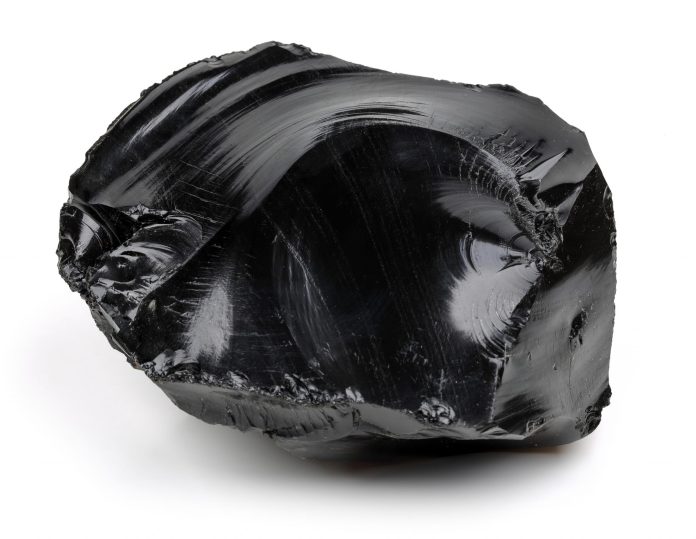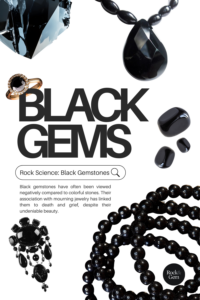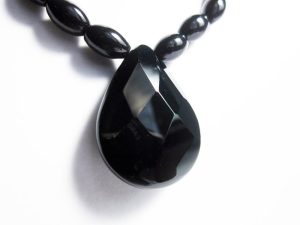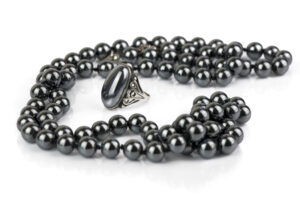
Black gemstones have long been something of a pariah among their brighter, more colorful brethren. Although undeniably beautiful, their historic use in mourning jewelry has linked these stones to death and grieving.
But black gemstones are now in the midst of a remarkable transition from gloom to boom. Their once-somber image has morphed into one of elegance and sophistication. Black gemstone jewelry has become a statement of boldness and confidence that fashion designers embrace for its compatibility with all colors. Its growing popularity in jewelry has focused attention on every aspect of black gemstones from beads and cabochons to faceted gems, and from schorl, onyx and jet to diamonds and sapphires.

Black Gemstones in Mourning Jewelry
Mourning jewelry originated in the Middle Ages as tiny skulls carved from jet. These were worn as “memento mori” (Latin for “remember that you will die”) pendants as tangible reminders of one’s own inevitable death.
By the late 1700s, when symbolism regarding death had shifted from memento mori to remembrance of the deceased and consolation for the living, black gemstones gained acceptance as public expressions of mourning. Their popularity peaked following the 1861 death of England’s Prince Albert, the beloved husband of Queen Victoria. Until her death in 1901, Victoria wore black-gemstone jewelry to mourn Albert’s death, establishing a fashion tradition that has endured until very recently.

Black Onyx and Schorl (Black Tourmaline)
Schorl and black onyx are among the mainstay gemstones of mourning jewelry. Black and opaque, they were fashioned into cabochons and beads or faceted into reflective gems.
Schorl, a hydrous sodium iron borosilicate also known as “black tourmaline,” is the most abundant member of the tourmaline mineral group. Its high iron content accounts for both its black color and its opacity. With a substantial Mohs hardness of 7.5, schorl is well-suited for jewelry use.
Onyx, the black variety of chalcedony or microcrystalline quartz, consists of silicon dioxide and has a Mohs hardness of 7.0. Inclusions of particulate carbon explain its black color and opacity.

Jet and Black Amber in Victorian Jewelry
Jet and black amber are both of biogenic origin. Soft and easily workable, they were used extensively in Victorian mourning jewelry. Their extremely low specific gravities (1.1 and 1.4, respectively) greatly minimized the weight of the large-beaded necklaces that were popular during the Victorian Era.
Amber, a fossilized tree resin, forms through molecular polymerization caused by the heat and pressure of long-term burial. In dark amber, sometimes classified as “black amber,” inclusions of foreign matter impart a dark color and near-opacity. True black amber is opaque, uniformly colored and rich in carbon particles produced through carbonization, a chemical process that reduces organic matter to elemental carbon.
Jet, a rare type of coal, is created by the alteration of biomass material in an oxygen-free environment. Unlike other forms of coal that occur in massive seams, jet occurs only in small, isolated pockets.

Other Black Gemstones: Hematite, Obsidian & Spinel
Lesser-known black gemstones used in Victorian mourning jewelry include hematite, obsidian and spinel. The silvery-black color of hematite, or iron oxide, is because of how its polished surface absorbs light equally over the entire spectrum. Hematite’s biggest use is in beaded necklaces.
Obsidian is natural volcanic glass. Its dark colors—black, greenish-black and smoky—are caused by the presence of iron and magnesium. Polished black obsidian has a glassy luster and is made into brooches and pendants.
Spinel, or magnesium aluminum oxide, has exceptional hardness (Mohs hardness 8.0) and a wide range of colors. Its black variety, actually a saturated shade of blue or gray, appears black and opaque in reflected light. With its unusually bright luster, black spinel is cut into gleaming gems with mirror-like facets.
Black Diamonds in Jewelry
Among the precious gemstones, black diamonds owe their color to tiny inclusions of graphite, the hexagonal form of carbon. They appear black and opaque only in reflected light; intense backlighting reveals their true dark green color. Black diamonds do not reflect or refract light internally; they are cut into gems that emphasize their brightly reflective facets.
Faceted black diamonds in white gold or platinum settings accompanied by sprays of colorless melee diamonds first appeared in jewelry in the 1990s. Previously, these dark stones had had only industrial value. Today, black diamonds are a bona fide precious gemstone with commensurate pricing. They achieved mainstream popularity after the 2010 movie Sex and the City 2 spotlighted a stunning, round-cut, five-carat, black-diamond engagement ring.
Black Sapphire and Star Sapphire
Sapphire, the gem form of corundum (aluminum oxide), occurs in every color. Red corundum is ruby; all other colors are sapphire. Black sapphires are intensely colored blue stones that appear black and opaque to the eye. Australia is the main source of black sapphires; until recently, these stones were heat-treated to lighten their color for sale as blue sapphires. Today, black sapphire gems are especially popular in engagement rings.
Also in demand are black star sapphires, very dark blue stones included with needle-like rutile crystals aligned with the stone’s hexagonal crystal structure. Despite their near-opacity, black sapphires transmit and internally reflect enough light to produce asterism, an effect that causes the reflections to appear as a ghostly, six-pointed star.
Once expressions only of death and mourning, black gemstones have become popular symbols of beauty, mystery and sophistication—an ongoing journey from gloom to boom.
This story about black gemstones previously appeared in Rock & Gem magazine. Click here to subscribe. Story by Steve Voynick.














